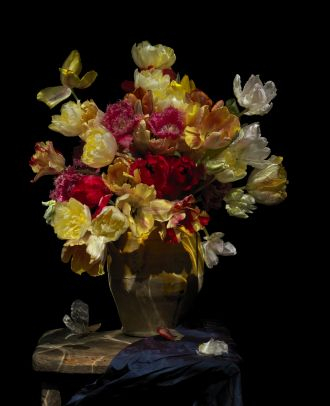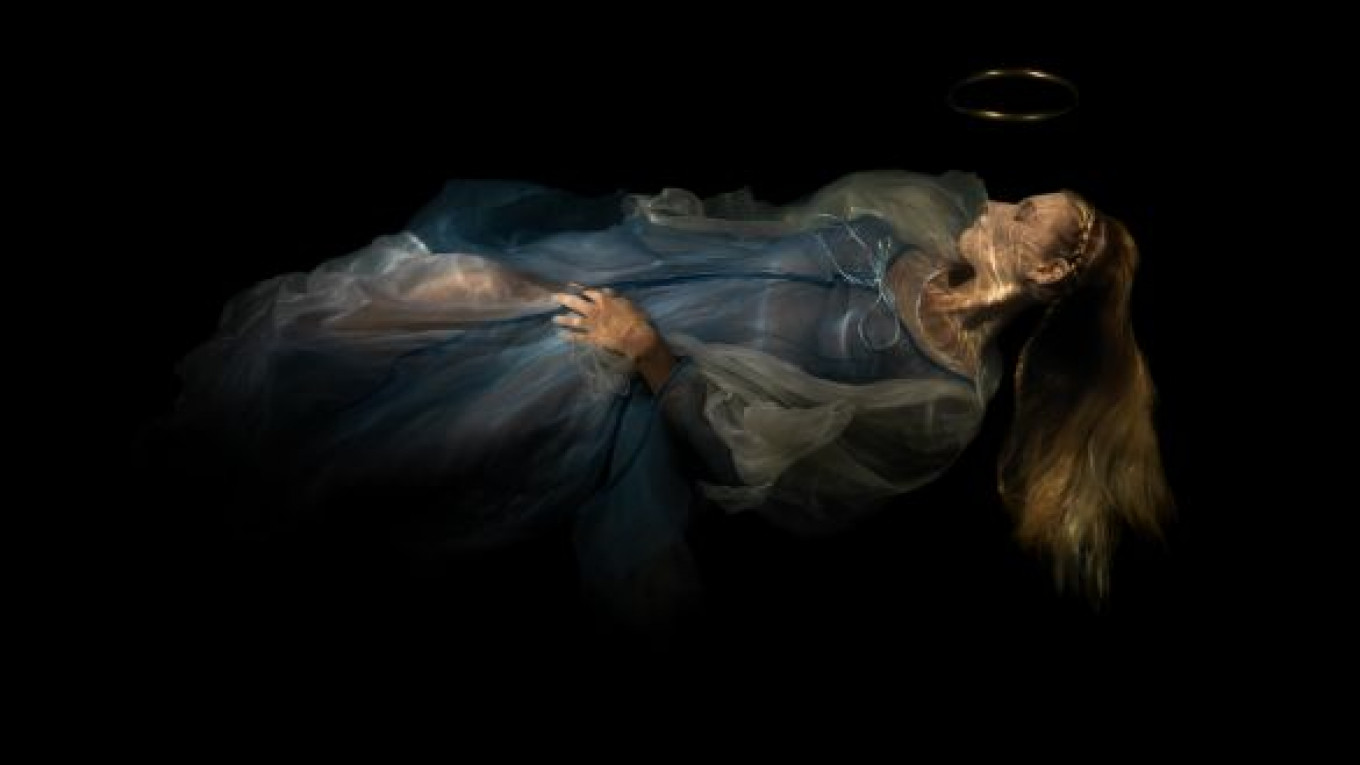Alexander James is not a photographer. Though best known for photographic works, James creates finely crafted sculptural scenes immersed in tanks of purified water. In some of his most recent works such as "Vanitas" and "Intersection," James has incorporated elements such as live butterflies, cut flowers and dead animals, which are used to form underwater still lifes that are often compared to classical paintings.
Though James is currently based in London, his studio has bounced around the globe during his career as an artist, and he is now preparing for a new move: In Spring 2014, James intends to move his studio to Moscow, where he will work with the Triumph Gallery to create a new series of works for display here in Russia. During a recent planning visit to Moscow, James spoke with The Moscow Times about his art and his upcoming move.
British visual artist Alexander James, best known for elaborate sculptural works submerged in immense tanks of water, tells Arts & Ideas editor D. Garrison Golubock about his recent move to Russia and his new studio and home an unfinished basement of the Krasny Oktyabr center.Q: What brings you to Moscow?
We had the foresight to send a series of small introductions of my work — a single piece, prints, unsigned — we sent them to six galleries in advance of my arrival. And we're really just making a point of seeing them all; it's very flattering that all of them are ecstatic about the work. Obviously "Vanitas" and "Intersection" are projects that are quite Russian in feeling actually — quite small, intimate works, almost like icons, but without the religion — they have this reverence to objects for their value, beauty and symbolism. So the reason for being here is actually just to firm that up. We're going to be announcing a show soon and we're actually going to be moving the studio out here. We're going to be producing the works in Moscow for the Moscow show, and that's kind of exciting; there's great potential for the work to develop in a way that I'm not seeing right now.
Something that came out of conversation with the galleries is that I don't want the works to be explicitly for the wealthy. I want to connect with Russians, everyday Russians, as well as the very wealthy — it's nice to have heavy collectors as well.
Q: Will your Moscow pieces also be photographic works?

The still lifes in the "Vanitas" series use exotic butterflies and flowers.
A: Well, I'm not a photographer [though] the execution of "Intersection" and my past 10 shows have been photography. But if you spend 10 months creating a piece; if you come to my studio and I'm making 24-karat gold haloes that float, so they are entirely hollow; if I'm growing growing exotic flowers that date to the 17th century to keep all my Vanitas pieces authentic; if I'm breeding rare species of butterflies; if I'm executing very scientific processes of water purification, and there's a camera in my hand for six minutes a day — [then you could say] I'm not a photographer. I do present sculptural works in my shows, very tangible, physical pieces though up to this point I've tried not to sell them because I'm very attached to those. The other works, "Grace" for instance — the main piece that nearly bankrupt the studio, took me seven months to produce. I took one image and then attacked it with a hammer — not drunk, by the way! But it's closure for me, whereas I could have kept that piece and actually reformed it as a sculptural work.
Q: So the photograph is just a representation of the work?
A: It's purely a documentary act for me. In fact the purity of the photography means that without postproduction, without this photoshop, without digital malarkey that everyone plays with, I can produce pieces up to four meters in size that are absolutely flawless, and it is of paramount importance. So I'm not a photographer — but photography is in there.
If you were in the studio, the camera is just a dusty object that is there for a second. For me, to define a year of work in a hundredth of a second means you don't understand what I'm doing. Many of my clients who have bought important, seminal works still have contact with the studio and tell me how much they love their painting, because they all look like paintings, the fact that it's a sculptural work and that I'm interacting with this huge volume of purified water, pretty much like holy water.
Q: Why is it purified water?
A: The thing is that it's heavily filtered. It goes through charcoal and other filters that we've designed specially in the studio. The butterflies need absolutely pure water because when they are underwater they are in a coma — they are alive — and if you have any sort of impurity in they water they could get an infection, so even though they are unharmed by the physicality of being in the water for ten minutes, you could give them a terrible infection. I want them to breathe, and the glass for instance, these underwater roses and poppies — they are underwater for six to eight days, so any impurity in the water and they start to rot. Also, the purity lends a further aesthetic — the fact that there is no postproduction means that the water has to be like mountain-driven snow.
It's quite a pain though — every time we put something in the water we need to swap the filters out or do a water change. At the moment we're working with quite a small tank, its about two tons — my largest for Ophelia was about 46 tons, so 7 meters by 6 meters by 2.5 meters. That's a big volume of water, and bear in mind that it's a black tank, so it's very eerie; to be around such a large volume of black water is quite staggering. I'm still excited by it and I've been an artist for 30 years. I first started with the water but I think actually being solely dedicated to the underwater process for 15 years now, and I still get very excited.
Q: How did you start doing this submerged work? How did that happen?
A: My first show was called "Beneath the Surface" and I documented the dynamiting of coral reefs, pristine reefs, to make for soft, lapping waves and new developments on a Caribbean island. I was a 16- or 17-year old kid. I had just started out, I had no idea what I wanted to do, hopeless. I sold three of 23 works and wound up in jail for 10 days — turns out its not a good idea to go to a Caribbean island and criticize the tourism industry, they get quite aggressive about that.
But I was talking to a curator at the Guggenheim — it was only about 12 years ago — and this new body of work, "Transparency of a dream" is actually fighting the idea: why underwater. This whole idea that a painting is intrinsically more valuable than a photograph — I think a photograph's failing and its pinnacle is that it is reproducible, and with this new body of work I'm taking that reproducibility right out of the equation by creating works where there is no photograph. We're actually selling the original transparency film, up to 8x10, in these beautifully executed frames. But this curator said to me, "well, a painting will always be worth more than a photograph, just deal with it." And, that to me was quite shocking. She wasn't talking about financial value, she was talking about value, how it is seen either in museums, how it is curated, how it is seen in the arts world. I've been a practicing artist for nearly 20 years, and it just ruined me. It completely destroyed what I was doing to be told so bluntly that I was worthless and that my work was of little value to the higher echelons of the art world.
Q: How did you react to this kind of rejection?
'A photograph's failing and its pinnacle is that it is reproducible … I'm taking that out of the equation.
Alexander James
A: I was lost and I retreated into my work. Eventually, I decided that I wanted to find a way of making the works more like a painting. So when we create this volume of water and the sculptural works under the water, I've actually got a paintbrush and I'm interacting with the surface tension of the water, and it's this elasticity and tension causing these corsets of light.
It's like standing in the water at the beach, looking down and seeing the way the sea makes the light dance on your toes: that's where I play, that's exactly where I am. And it's not just causing facets of light to bounce around the sea — I can actually move elements, I could make your big toe shorter, I can stretch and contort. In some ways it's very Pollock-esque. I'm using a stick or a brush to literally directly mess around with the color, the shape. All of the light effects you see in the pictures are in essence made by hand.
Imagine you paint an oil painting of this scene and in an instant, you have a thousand colors. Then imagine getting a dry brush, wetting it, and then being able to have complete control over everything.
I think to my team it must be a bit of a laugh at first because it seems quite accidental. Sometimes we create a scene, and there is something that is deeply offensive to me but is unchangeable. That's where we use my ability to interact with the scene to change the part I don't like, and I think that level of control is still something of a shock to my crew.
Q: Some of the materials that you use, such as the butterflies and dead animals you've used in some works, are quite unique. What was your motivation for using these? What do you mean when you say that your work is about life?
A: Of course, we're all glossing it up so much, but I think of myself as a memento mori sculpture artist who plays with painting and photography. It's a difficult one to nail without being in the studio. With regards to the dead animals, most of the animals passed away in my lap when we were working with a veterinary hospital. My work is a celebration of life.
I've moved to abstract work now, and Moscow will be figurative — I can let you know that. So, think Ophelia, which we've already done in "A Beautiful Announcement of Death". This is in one of my very large tanks, and I re-enacted a Paul Delaroche painting "Death of a Martyr."
So there are two Ophelias. It's an interesting story — for some reason this particular piece became known as "Shakespeare's Ophelia," the difference being that one is a martyr and was murdered. All of my work is related to personal experience: I had the great misfortune of having a lover commit suicide in very close proximity to me, and the idea that this particular artwork from the 1740s became known as Shakespeare's Ophelia actually played on me, because she was murdered. So I created two, and one is the Suicide Ophelia. I've put her in a hand-embroidered bridal gown, which created some dialogue for me as I'm sure you'll understand. Like Manet, I believed in filling the corpses with flowers, so each has a separate space with biblical-scale floral works. In the show, the image was 2.8 meters. So, this is "Turned From Heaven's Doors" — as you know, suicides are not allowed into heaven. So, this was from a series called "Love Suicide" or "A Beautiful Announcement of Death." Supposedly the most beautiful announcements of a person's death were written by Shakespeare.
Contact the author at [email protected]
A Message from The Moscow Times:
Dear readers,
We are facing unprecedented challenges. Russia's Prosecutor General's Office has designated The Moscow Times as an "undesirable" organization, criminalizing our work and putting our staff at risk of prosecution. This follows our earlier unjust labeling as a "foreign agent."
These actions are direct attempts to silence independent journalism in Russia. The authorities claim our work "discredits the decisions of the Russian leadership." We see things differently: we strive to provide accurate, unbiased reporting on Russia.
We, the journalists of The Moscow Times, refuse to be silenced. But to continue our work, we need your help.
Your support, no matter how small, makes a world of difference. If you can, please support us monthly starting from just $2. It's quick to set up, and every contribution makes a significant impact.
By supporting The Moscow Times, you're defending open, independent journalism in the face of repression. Thank you for standing with us.
Remind me later.






